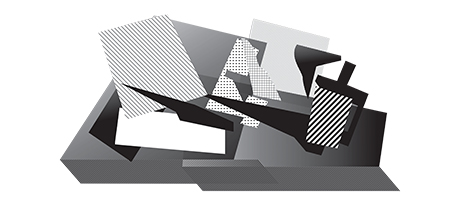By Julyssa Lopez
In 1913, a cohort of artists teamed up for an exhibit that shocked the nation.
The famed Armory Show took place in New York City, effectively opening a window into experimental styles that permeated the European art scene at the time. Artists in the show, who included heavyweights like Pablo Picasso and Henri Matisse, explored the changing world of the early 20th century through cubist, fauvist and futurist works that would send American artists down a path toward modern art.
One hundred years later, the George Washington University’s Luther W. BradyArt Gallery is recreating this phenomenon in “Decenter NY/DC: An Exhibition on the Centenary of the 1913 Armory Show,” which opens today. Twenty-seven contemporary artists from New York and Washington, D.C., have come together to tackle the same questions about perception and an ever-changing world painters contemplated a century ago.
The exhibit was originally shown in the Henry Street Settlement’s Abrons Arts Center in New York City, where it was curated by Andrianna Campbell and Daniel S. Palmer. After visiting, Director of the Brady Art Gallery Lenore Miller decided to celebrate the spirit of 1913 in D.C. by bringing the show to GW’s campus.
“In its 120-year history, Henry Street Settlement has been a beacon of hope for New Yorkers,” explained Ms. Miller. “To honor the centenary of the 1913 Armory Show, we decided to invite them to curate a tailored version of the New York showing to include some D.C. artists. This exhibition links New York and D.C. in an aesthetic collaboration to inaugurate the academic year.”
Decenter NY/DC starts with Andrea Geyer’s piece “Indelible,” made up of ink paintings with names of female modernists who were central to the Armory Show movement, but have been long forgotten. The piece introduces questions about how the legacy of the show is perceived 100 years later.
One of the most important postulations of the exhibit is how world views have changed with technology, specifically in regards to today’s ubiquitous digital computing technology. Canadian artist Douglas Coupland’s “Hey Boy, Hey Girl, Superstar DJ,” at first glance is a straightforward geometric piece; on closer examination, it’s a series of QR codes that can be scanned with smart phones to reveal certain messages to viewers. Facets of the digital world exist everywhere, the piece suggests, and viewers can gain access to new data and new information if they’re equipped with the right tools and technology—and they probably are.
The exhibit also includes pieces from Mexican artist Gabriel Orozco, New York-based artist Andrew Kuo and Brooklyn-based multimedia artist Liz Magic Laser. Ms. Laser’s video piece, “The Digital Face,” consists of two video screens playing at the same time from opposite sides of the gallery. A pair of contemporary dancers reinterprets the body language of U.S. politicians by mimicking their gesticulations and expressions. The piece examines the “performance” of governing leaders—significant in an age where nearly all historical moments are televised and brought to directly to the screens of their constituents.
Victoria Greising has a special piece leading up the stairs of GW’s Media and Public Affairs building, leading visitors into the gallery. The artist, an American University graduate, created a web-like installation called "Unnavigable Space" made of found previously used clothing and sheets that takes over the entire staircase. The Brady Gallery collaborated with Events & Venues to put the installation together.
Part of the exhibit lives on the web. Artists in the show were asked to invite colleagues to create art pieces, who in turn asked another group to make even more work. The result is an online gallery showing all of the participants. It emulates the intricate, expansive world of social media networks, bubbling out wider as more artists join.
“We see things differently in 2013 than people did during the first half of the 20th century,” Mr. Palmer said. “[Ms. Campbell] and I wanted to bring together a group of contemporary artworks that explore the dramatic changes in perception precipitated by our digital age, and in doing so, highlight how these new conditions have deeply impacted the way we all experience the world today."
Decenter NY/DC will be on view until Dec. 20. A reception will be held Sept. 25.


